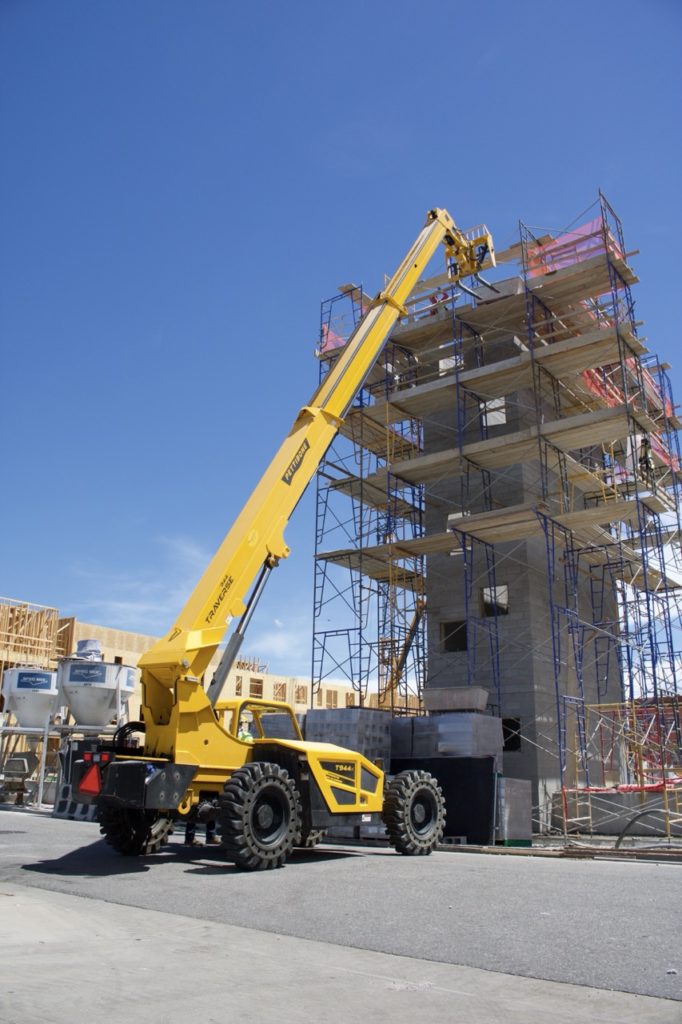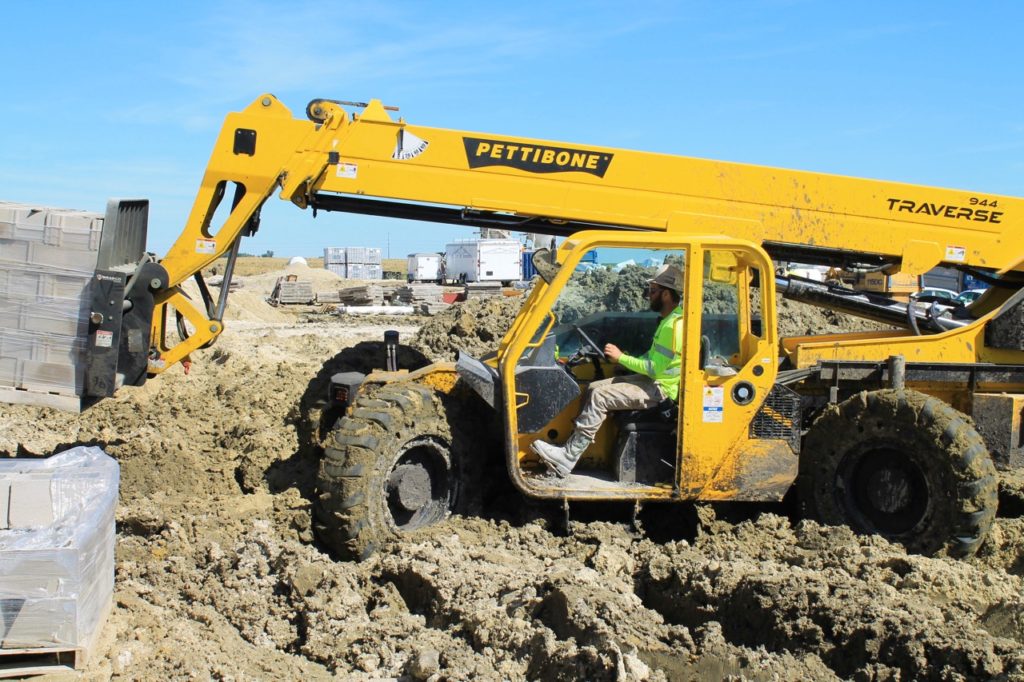Safe Telehandler Design and Operation
Words: Mitch Fedie
Words and Photos: Mitch Fedie, Product Manager, Pettibone/Traverse Lift LLC
Telehandlers are so commonly used for construction and masonry projects that the work they do can sometimes be taken for granted. In reality, every crew member on a jobsite should always remember that telescopic handlers are powerful machines that need to be operated with full attention to detail.
Whether placing palletized loads at height, moving mortar tubs or tackling any other material handling task, safety must be a priority at all times. Safe operation primarily comes down to training; however, factors like machine design, maintenance, and using the correct capacity telehandler for the job are also critical considerations.
Proper Training
The reason telehandlers are used in the first place is that they are capable of providing substantial reach and height while moving loads. To use a piece of equipment that is powerful enough to handle heavy materials, the operator must be trained and must remain observant on the jobsite. There is always a chance that a telehandler’s combined center of gravity will shift, creating the risk for the machine to overturn when it’s not being operated in the proper manner. Displaced loads and falling objects are an extreme hazard.
The good news for operators is that today’s telehandlers often have simple, intuitive designs that allow even less experienced users to become proficient quickly. Still, training is necessary for everyone, from operators to service technicians, so that everybody who handles the machine has proper instruction for both using and maintaining it. Dealers and manufacturers can assist with general product training, detailed service training and operator certification.
Smooth Hydraulics
For over 50 years, telehandler design has gradually evolved to keep improving safety, productivity and uptime. Today’s leading telehandlers are engineered to give the operator full confidence in the machine, whether they are regularly using a telehandler they own or utilizing a rented unit.
Much of that confidence comes from the feeling of being in control, which can be directly linked to the smoothness of the hydraulic controls. A high-quality hydraulic circuit will provide an intuitive feel and eliminate jerky movements when lifting and landing loads. Lifting tasks are greatly simplified when using single joystick, pilot operated controls that cover all boom functions.
A recent design trend is cushioning the cylinder to dampen the end of strokes, both when extending and retracting the boom, to help prevent the potential spilling of a load. Users can also benefit from frame leveling capability, where a sway cylinder automatically balances the load on the forks as the machine travels across uneven terrain.

It’s important for operators to feel secure and know the machine will remain stable when pushing the telehandler to its top reach or full load capacity. Precision engineering is critical to providing peace of mind when handling heavy masonry materials.
Safely Landing Loads
There are obviously variances in how different telehandler brands operate, as well as different machine styles, such as fixed boom and rotating telehandlers. Long-time users of the popular Lull brand of telehandlers are familiar with the concept of the horizontal traversing boom, a feature now only offered to the market on Pettibone Traverse telehandlers.
Unlike a traditional fixed boom telehandler, the tower portion to which the boom is attached slides forward on a Traverse model. The traversing carriage is mounted to the chassis with a series of slide pads and pulled forward or pushed back with a hydraulic cylinder.
With this traversing capability, an operator can simply and safely place a load on the target landing, release the contact of the forks, and traverse the carriage backward to disengage the forks. With a fixed boom, the operator must coordinate several motions of the controls to withdraw the forks from the payload, leading to intermittent contact with the load or the landing.
The practical result of this is that a traditional machine actually loses about three feet of its specified lift height, whereas a traversing machine is capable of landing a load at the telehandler’s maximum lift height.
Additionally, a traversing unit does not need to physically drive back and forth during the landing process. Because the boom itself slides forward and back to place the load, the machine can simply be driven into its desired position and remain stationary, helping to avoid potential hazards that could arise while driving back and forth, particularly on a rough terrain jobsite.
Masonry contractors, in particular, have long enjoyed the benefits of these telehandlers. The added precision and reduced load movement makes these machines ideal for moving mud buckets full of mortar without spilling, or for landing a load of concrete blocks without disturbing the stack. By keeping operating maneuvers to a minimum and avoiding jerky movements, sliding boom units are less likely to compromise a load.
Right Machine for the Job
Having the proper size machine for the job at hand is a critical step in choosing a telehandler. While some users may not be planning to lift extremely heavy loads very often, it’s always important to consult a machine’s lift chart. The operator must ensure there is ample capacity available to safely handle the anticipated loads as the telehandler is boomed farther up and out.
For example, a 9,000-pound-capacity telehandler with 44-foot lift height may be capable of tackling most of a contractor’s jobs; however, when working at increased heights or when needing extra reach to operate from a street-side position, a 10,000- or 12,000-pound machine and/or a higher-reaching 56-foot unit may be necessary to accommodate the de-rating of the boom as it extends out fully with a load.
Clear Vision
Visibility is another key component for equipment operator comfort and overall jobsite safety. Some manufacturers will tout their visibility from the cab, only for those clear views to be diminished once the telehandler is put into a working condition.
The main blind spot for a telehandler operator is the area looking back toward the curbside, so the best-designed machines are oriented to increase visibility in that particular area. It’s common for telehandlers to have a side-mounted engine, but there is a fine line between where the engine position does or does not allow adequate curbside visibility.
Other components can impact visibility as well. Telehandlers that feature a single lift cylinder, rather than double cylinders, typically have better sight lines to the rear. Another issue is that many machines have an extra set of slave cylinders near the pin where the boom is hinged, which can obstruct the operator’s vision. Machine designs that do not require slave cylinders provide a more open rear view.
Back-up cameras and object detection sensors have become popular accessories. Still, it’s very important to allow the operator to see firsthand – with clear sightlines all around the machine – when maneuvering on a masonry construction site.

Maintenance
Proper service is also important for telehandler safety. Make sure routine checks are done daily. Between jobs, perform regular maintenance and simple visual inspections. Maximize your investment and ensure it’s always safe to use by keeping it in good working order.
Telematics has emerged as a key technology for telehandlers. Equipment owners can now constantly monitor anything service-related on the machine with a computer or smart phone app.
Safety is King
Safely elevating heavy loads to the height and distance that telehandlers can attain requires an observant operator and a machine in proper operating condition. Take the time to learn the manufacturer’s safe operating guidelines to ensure productivity and safety for all involved.
For more information, visit www.gopettibone.com.